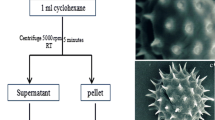Abstract
Adhesion occurs both between pollen tubes and between the pollen tube and transmitting tract epidermis (TTE) in lily. The stylar matrix secreted by the TTE can be isolated and used in an in vitro adhesion assay for pollen tubes. This bioassay was used to isolate two stigma/stylar adhesion molecules in lily: a pectic polysaccharide and a small cysteine-rich, basic protein we named SCA (stigma/stylar cysteine-rich adhesin). Both molecules were purified and used in an adhesion assay. Adhesion in the assay can be disrupted by treatment of the pectin with polygalacturonase and of SCA with proteinase K. The two molecules bind to each other in a pH-dependent fashion, and this binding is necessary for the adhesion assay to work. Antibodies to each of the molecules show their localization at the sites of pollen tube adhesion in the style. Pollen does not produce SCA but does bind this protein in vivo and in vitro. In vivo functional analyses are necessary to establish the roles of these molecules in lily pollination.
Similar content being viewed by others
Author information
Authors and Affiliations
Additional information
Received: 29 October 2000 / Accepted: 17 April 2001
Rights and permissions
About this article
Cite this article
Lord, E. Adhesion molecules in lily pollination. Sex Plant Reprod 14, 57–62 (2001). https://doi.org/10.1007/s004970100076
Issue Date:
DOI: https://doi.org/10.1007/s004970100076




